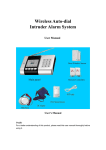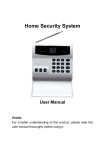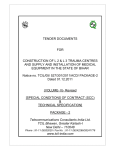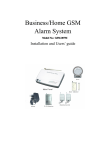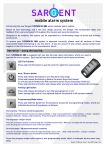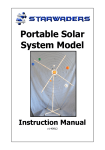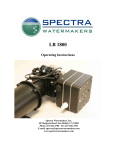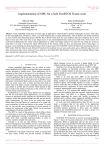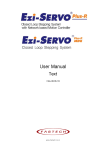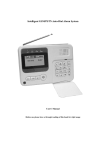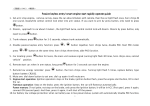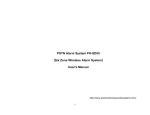Download Six-defense zone Display Alarm System
Transcript
Six-defense zone Display Alarm System User Manual Feature 1. Anti-interfere function. When someone interferes it with same frequency, the control unit will activate siren to alarm. 2. Support anti-decode with remote control 3. 6 programmable Defense zone available, with status LED. The control panel can register 99 sensors and detectors. Every defense zone can set independently arm, disarm, delay alarm and so on. 4. Have the function of “one-key arm”. User can start “Home arm” or “Out arm” freely by keeping pressing one key on remote control 5. Can set the reminder sound of defense zones. Will remind users of remembering arm the alarm system when going out. 6. Can work with other products of our company. Such as wireless big outdoor siren and mini siren and YL-007AS. 7. It stores 2 groups of monitoring center and 6 groups of user phone numbers to dial out and play the recorded message if there is an alarm. 8. Can arm/disarm with remote control or keypad on the control panel 9. Can arm/disarm/listen-in by calling the host phone number (The phone numbers of control panel). 10. Have the function of reminder for circuitry failure. For example, if telephone line is cut or short, the control panel will alarm. 11. Have the superior of connection 12. Have in-built backup battery and can continue to work and last for 8---10 hours when electricity is cut or in failure. How Do I install the alarm system? I Installation of Control unit a. Insert the siren to the port of control panel, and connect telephone line with the port of “input” and “output” with the telephone set. That is to say, the telephone must be connected with control panel. The telephone can work normally. b. Power the system on and switch it to “ON”, the power status will be blinking and sound “beep” which shows the control panel works normally. It will sound three “beep beep beep” every 30 seconds, which helps users remind of setting alarm phone numbers. The sound “beep” will disappear when you finish the alarm phone number setting. Please press “ ” to make the system disarmed to avoid it activate the siren to alarm when registering sensors. Attention: a. Try to install the control unit in the center of defense zone and pull antenna and make it up for getting more wireless receiving distance. b. Installation position should be far away with huge metal objects and wireless device. c. Connect the trunk line with control panel in order that it can dial out in the first second when there is an alarm. d. Should be installed in a shelter. II. Installation of door sensors: Door sensors are used for detecting the status of open and close of windows and doors. It will detect it and send the signal to control panel. Fix the transmitter box and magnet to door case and door. (You’d better fix it again with bolt if you want it fixed strongly.) Caution: A Magnet should be close to signal status and make the transmitter box and magnet as close as possible (<10mm). B. In order to get the best receiving distance, you should pull the antenna and make it upwards C. If the indicator light of door sensor are still blinking, it shows battery fails. So please replace it as soon as possible. III. Installation of Wireless PIR motion Sensors: PIR Sensors are used for detecting if someone moves within in a certain place. Fix it on the wall, 2—2.2meters high and you should adjust the position to make it face to the defense zone. Caution: How Can I set up the alarm system? Before any operation, please enter passwords and #.(Default is 1234). Two beeps show that the operation is successful, four short beeps shows fails. You have to try again in this case. Please press # to exist the programmed status. System will exist automatically if there is no any order within 30 seconds. 1. Record alarm message. Input 6 # to record message within in 10 seconds and you will hear a beep. It will exist with two beeps automatically after 10 seconds. Every recorded message will replace the last message. The message should be short and clear. For example: “This is xxxxx building and room xxx, please come to offer help ”. Play the recorded message, please press 6 *. 2. How do I Register sensors or detectors with control unit? First, as we all know, every detector has its unique ID. It must be registered with the control unit so that it can be identified during working. When it detects unwonted status, it will send signal to control panel .If it did not register with control unit, the control unit would not identify it and could not receive the signal, so the alarm will be failed. Before registering, please input 7#, with a beep, the arm status flashing, it shows on the status of registering. Now you can start to register sensors. Please collect all detectors including door sensors, PIR detectors, and gas/smoke detectors together with the control panel and make sure their battery inside and can work normally. Switch on control panel (power LED is on), and trigger the sensors or detectors you are going to check in. 3. How to trigger sensors or detectors? When the control panel is powered, start to register them. For door sensors, just remove the two parts of door sensor and remove back, it will beep and the status LED flashes, which shows successful. And for PIR Sensors, you can turn the switch to “on” and the system will beep, which shows successful and then turn it to “off” to avoid wrong alarm. For remote controllers, you can press any key on its panel (three keys on it), and the system also beeps. For gas and smoke detectors, there is a black switch on the left side; you can press it to register it with control unit. For break sensor, you can put it on a desk and then shake the desk, it will send a signal to control panel. The control panel will response with a beep sound, which shows successful. After finishing registering, please enter # to exist (two beeps.). 4. How to delete all coded information if you want to recheck-in? Under the status of registering, please input 7*. It will sound “beep, beep” two times, all coded information has been deleted. IV. How Can I setup the Alarm Phone Numbers? (The phone Nos. that will be dialed out when there is an alarm). Command: 31* the 1st User phone number # 32* the 2nd User phone number # 33* the 3rd User phone number # 34* the 4th User phone number # 35* the 5th User phone number # 36* the 6th User phone number # 38* the 1st phone number of monitoring center # 39* the 2nd phone number of monitoring center # Note: Do not setup the last monitoring center numbers if you do not have monitoring center. You can enter a blank order if you want to delete a Alarm Phone Number. Fox example: You want delete the 4th Alarm Phone Number, only input 34* #. Operation sketch: Input password (default 1234 # ) Sensors Register Record Voice Message 6# 6* Record message ReplayThe message 7* Register sensors with control panel. 7# Delete all stored information Alarm Phone No. Settings. 31* the 1st User phone number # 32* the 2nd User phone number # 33* the 3rd User phone number # 34* the 4th User phone number # 35* the 5th User phone number # 36* the 6th User phone number # 38* the 1st phone number of monitoring center # 39* the 2nd phone number of monitoring center # There are six-defense zones, so you can install sensors in any of defense zone. You will know what sensors are triggered from the screen of control panel. You can input 02+# and then trigger sensors and then enter into the next defense zone. Enter 7# and trigger sensors Zone 2: Enter 02 # and trigger sensors Zone 3:3: Enter 03 # and Zone 4: Enter 04 # and trigger sensors… -and so on V. How to Modify passwords? Command: 10* passwords # (passwords must be digitals) This password is used for remote control. Users should setup it confidently ****The following options can be used for special operations. Users, who do not connect the alarm system with monitoring center, do not have to read it. VI. Defense Zone Setting: You can setup your sensors or detectors into “a special defense zone”, which can make some detectors not work when there is an alarm. Command: * Zone No.+ 2 +X + [#]. X will be: 1 for Immediate Zone. It can activate the siren and order the control panel to dial out Alarm phones immediately if the detectors in this defense zone detect some unwonted status. 2 for Delay Zone. Activate siren and dial out in 30 seconds when detectors in this zone find something unwonted. 3 for Urgent Zone. It will activate siren and dial out users phone numbers no matter it is arming or disarming when the detectors in this defense zone are triggered. 5 for Inner Zone. It will not activate siren and dial out users phone numbers in the status of Home Arm. 0 for Closed Zone. It is closed temporarily and is used for arming in sub-defense zone. E.g.: If you want the second defense zone to be inner zone. You can input: *0225#. Reminder for application: Usually, we setup the door/window sensors installed in windows, veranda and doors as “Immediate Zone”. The detectors in this area will activate alarm in any mode of arming; If you setup wireless PIR detectors as the “Inner Zone”, they will work in the mode of “Out Arm”, but do not work in the mode of “Home Arm”; You can setup the doors in the main gates as “Delay Zone” if you do not want to take remote control when going out. In this case, you can disarm the system within 30 seconds after opening the door, but the alarm system will not have enough time to activate siren and dial out alarm phone numbers. 6. Start/close reminder for defense zone. If you start the reminder for defense zone, it will “ beep beep beep” for three times to remind users of arming. Command: Start: * Zone No.+ 71 # Close: * Zone No.+ 70 # 7. Start/close the function of anti-interfere. When starting the function of anti-interfere in arming status, it will activate siren to alarm (not calling users) if someone interferes the alarm system with same frequency. Command: Start: 17 * 1 # Close: 17 * 0 # 8. Start/close the function of anti-decode. In order to Prevent someone from decoding the alarm system, we often start this function. Once starting this option, the signal from remote control is screened and only the keypad in the control panel can arm the system Command: Start: 18 * 1 # Close: 18 * 0 # 9. Start/close the reminder for phone line trouble. It will tell you when the phone line is cut or short. It will sound “beep” three times every 10s. Command: Start: 22 * 1 # Close: 22 * 0 # 10. Setup the times of ring. You can setup the times of ring by calling the Host phone number. Command: 12 *XX #. XX shows times of ring, from “00--12”. 00 means ring is closed. In that case, the system cannot dial out phone numbers when there is an alarm. 11.Setup the time of siren. You can setup the siren to make it last 5 minutes, 10 minutes or 30 mins. Command: 29 * XX #. (XX is 00---30minutes.) 13. Reset: You can delete all registered information including passwords in order to return the original status before living factory. Command: 0000 #. How to control the control unit with remote controllers? VI. Instruction of Use. 1. Out Arm: Press “ ” or keep pressing the key “OUT”, with the status LED flashing, the system will enter into the mode of Out Arm. The system will enter into the mode of Out Arm if you press the key “ ” and continue to press “ ”. 2. Home Arm: Press “ ” or keep pressing “Home” for 2 seconds, with the sound “beep”, the status Led flashing, the system will enter into the mode of Home Arm. In this working mode, the detectors in “Inner Defense” will not work. 3. Disarm. Press “ ” on remote control or input password+[DISARM] on control panel, the system will disarm. 4. Emergency Help: (SOS) Meeting urgent incident you can press “ ” on remote control or pressing the key “PANIC”. Note: Please wait 10 seconds or so repress disarm and enter into next operation. It needs time to be activated again. 5. The process of receiving an alarm. What should I do when I receiving the phone call from the alarm system? When detecting something unwonted, the detectors will activate the siren and dial out alarm phone numbers and the status LED will be on. User can answer the phone and do it according the following steps: Press * to start the function of listen-in for 30 seconds. (you will hear what is happening around the alarm system.) Press # to confirm that you have already received the signal of alarm and stop alarm. If you do not input “#”, the alarm system will continue to dial out all alarm phone numbers circularly. 6. Remote control: You can call the host phone number to control the system to make them arm or disarm by input passwords+ #. If the password is correct, the system will sound “beep” two times. If wrong, it sounds “beep” four times. And then you can control the system with following command: Press “1” to arm. (Make sensors working) Press “2” to disarm (make sensors stop working) Press “*” to enter into the mode of 30 seconds of listen-in. Press “#” to exist. Note: The system will hang off automatically if passwords are wrong for 3 times or no any order in 20 seconds. Use of remote controller: 1. Arming button – press it to arm system. Siren will have a short ring. 2. Disarm button – press it to disarm system. Siren will have two short rings. 3. Panic button – press it and siren will start to ring continuously, alarming the others. The following sensors can be optional: -Additional wireless products PIR Detectors Door / Window Smoke Detectors Remote Controls Panic Buttons LPG Gas Detectors gap sensors Optional sensors/detectors are packed separately. It includes remote controllers, wireless PIR, wireless gap sensor, wireless gas detector, wireless smoke detector, panic button, baluster, according your specific needs. Explanation of alarm systems: 1. Working elements: An alarm system contains two parts—a control panel and some sensors. When sensors detect unwonted situation, they will send signal to control panel. When control panel receives the signal, it will activate siren to make 110dB sound to inform people around and dial out preset phone numbers for help. Control Panel Send signal to the control panel Smoke Detectors PIR Detectors Door / Window Contacts LPG Gas Detector Remote Controls 2. Function of each sensors/detectors and control panel. Sensors/detectors include Door/window contacts (sensor), PIR Sensor/detectors and smoke/gas detectors, remote controls. 1). Window/door sensors are used to induct the close and open of doors or windows. If a door is opened, it will send signal to control panel. 2). PIR Sensors: detect the motioning object with infrared activities 3). Smoke/gas detectors: detect smoke or gas leak. When detecting smoke or gas , it will send signal to control panel. 4). Control panel: like a brain of the alarm system. It will activate siren to make 110dB sound to attract attention from people pass by and auto-dial preset phone numbers to call police and owners. 5). Siren: To make 110 dB sounds. 3. We sell at a standard package. Customers can add more sensors/detectors if needed. 4. Wireless sensors do not need wire to communicate with control panel. They use wireless communication; so wireless sensors/detectors have to be registered with control panel before working so that control panel can identify them when they send signal to control panel. Standard pack components 1 the alarm system 1 wireless infrared detector 1 wireless door magnet detector 1 internal alarm sounder 2 remote controllers, 1 12v dc power supply 1 instruction manual Technical Parameters Operating voltage: DC6V Average power: AC/DC exchanger 2A. Wireless receiving distance: ≥ 100m Operating Frequency: 315MHZ or 433.92, 900-1800MHZ Customized. Operating voltage: 12V/220/110VAC Wireless receiving distance: ≥ 100m-250m Outer Alarm Siren Volume: 110 db Working Condition: Temperature –10℃~+ 40℃ Humidity ≤ 90% Capacity for Wireless Device: 32 Wireless Gap Detector Power Supply: DC12V(inner 12V battery) Static Current: ≤20 uA Transmission Current: ≤15mA Transmission Frequency: 315/433MHZ±0.5MHZ Transmission Distance: No obstacle 80m Interval Distance: 15 mm Working Condition: Temperature –10℃~+ 40℃ Humidity ≤ 90% Wireless P.IR Detector Power Supply: DC9V (inner 9V battery) Static Current: ≤100 uA Transmission Current: ≤20mA Transmission Frequency: 315/433MHZ±0.5MHZ Transmission Distance: No obstacle 80m Detective Speed: 0.3~3m/s Detective Distance: 5~12m Detective Range: Horizontal 110° Vertical 60° Working Condition: Temperature –10℃~+ 40℃ Humidity ≤ 90 Remote Controller Power Supply: DC12V (inner DC12V battery) Static Current: 0 Transmission Current: ≤15mA Transmission Frequency: 315/433MHZ±0.5MHZ Transmission Distance: No obstacle 80m Working Condition: Temperature –10℃~+ 40℃ Humidity ≤ 90











